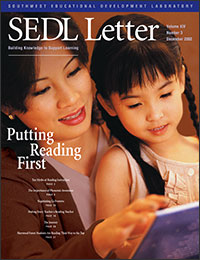Editor's Note: Putting Reading First
Imagine my surprise when halfway through my son's kindergarten school year, his teacher stopped me one day and asked, "How about our little reader?" It seems he had learned to read early and without my even knowing it. He is one of the lucky students who started school with strong pre-literacy skills and an excellent kindergarten teacher. And his kindergarten class was fairly small as public schools go, with only 12 students in the class.
With passage of the No Child Left Behind Act and its Reading First component, there is the expectation that we can help all of these students learn to read early and well.
As we know, not all students are so lucky. Some come to school without knowing the alphabet or understanding the concept of print. Others must learn to read in a language that is not their native language. Some are put in crowded classrooms, and still others have teachers who haven't received adequate training in reading instruction. With passage of the No Child Left Behind Act and its Reading First component, there is the expectation that we can help all of these students learn to read early and well. It will be a challenge, however, as states, districts, and schools scramble to meet the tougher new requirements as well as identify research-based programs and practices.
In this issue of SEDL Letter, we touch on some of the issues related to Reading First. "Ten Myths of Reading Instruction" is a rundown of some fallacies around reading instruction. "The Importance of Phonemic Awareness" addresses one of Reading First's five essential components of effective reading instruction. We also look at how to help struggling secondary readers in "Making Every Teacher a Reading Teacher: Putnam City Secondary Educators Work to Help Struggling Readers" and how to meet the needs of migrant students in "Negotiating La Frontera: Reading and the Migrant Student." New Orleans teacher Kathleen Theodore offers hope with her essay, "The Journey," about how she struggled to teach beginning readers as a novice teacher. In our final piece, "Sherwood Forest Students Are Reading Their Way to the Top," we visit a New Orleans school where everyone puts reading first.
The December issue marks the first time we have included a few activities for teachers to use in the classroom. Results from our survey last year indicated that teachers wanted the magazine to include instructional materials, so we hope these might be useful to some of our readers. Also, this issue of SEDL's magazine is the first with our name changed from SEDLetter to SEDL Letter. And it is fitting that the change coincides with our issue's theme of "Putting Reading First." Although the magazine has been called SEDLetter for about 15 years, we decided it was a difficult title to read.
Happy Holidays from all of us at SEDL!
The Southwest Educational Development Laboratory (SEDL) conducts field-based research and development; develops and offers training programs; and works with educators, parents and community members, and education decision makers.
Next Article: Ten Myths of Reading Instruction

